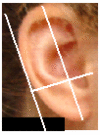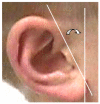Detailed assessment of the ear in Cornelia de Lange syndrome: comparison with a control sample using the new dysmorphology guidelines
- PMID: 19764039
- PMCID: PMC2764032
- DOI: 10.1002/ajmg.a.33073
Detailed assessment of the ear in Cornelia de Lange syndrome: comparison with a control sample using the new dysmorphology guidelines
Abstract
The literature abounds with reports of malformation syndromes in which human external ears are variously described as dysplastic, abnormal, large/small, low set, typical, or in some way unusual. Rarely is the ear well illustrated or described in meaningful detail. With few exceptions, such as Down syndrome, there is no real understanding of the degree to which ear morphology is affected in a specific syndrome. This paper describes a retrospective attempt to apply the recently published Morphological Definitions of the ear to compare a control sample of convenience with a group of patients with Cornelia de Lange syndrome (CdLS) (all six papers in this issue are available online, open access at http://www3.interscience.wiley.com/journal/121641055/issue). Although this study has a number of limitations, it demonstrates that the method can be successfully applied and is capable of producing data that can be subjected to statistical analysis. The ears of the patients with CdLS were significantly different from the controls over a number of descriptors, the most significant of which included more frequent apparent posterior rotation, a shorter more serpiginous antihelical stem and sharper antihelical to inferior crus angle, a shorter crus helix, a more V-shaped incisura, and a smaller lobe.
Figures






References
-
- Deardorff MA, Kaur M, Yaeger D, Rampuria A, Korolev S, Pie J, Gil-Rodriguez C, Arnedo M, Loeys B, Kline AD, Wilson M, Lillquist K, Siu V, Ramos FJ, Musio A, Jackson LS, Dorsett D, Krantz ID. Mutations in cohesin complex members SMC3 and SMC1A cause a mild variant of Cornelia de Lange syndrome with predominant mental retardation. Am J Hum Genet. 2007;80:485–494. - PMC - PubMed
-
- Carey JC, Cohen MM, Jr, Curry C, Devriendt K, Holmes L, Verloes A. Defining morphology: standard terminology for the oral region. Am J Med Genet Part A. 2009;149A:77–92. - PubMed
-
- Hall BD, Graham JM, Jr, Cassidy SB, Opitz JM. Defining morphology: standard terminology for the periorbital area. Am J Med Genet Part A. 2009;149A:29–39. - PubMed
Publication types
MeSH terms
Grants and funding
LinkOut - more resources
Full Text Sources
Medical
Research Materials

